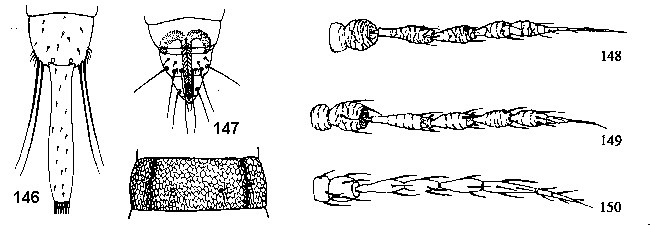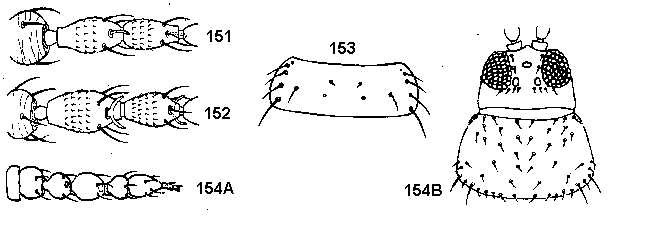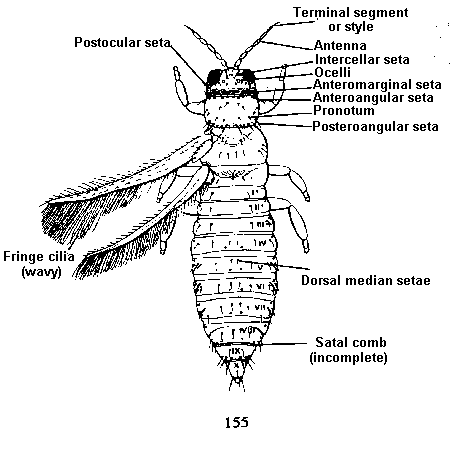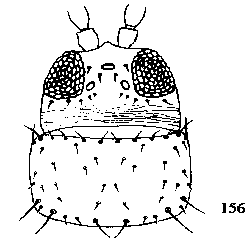
Return to: MREC Home Page
Return to: Index
THRIPS
Key to Eleven Species of Thrips Found in Greenhouses
1. Last abdominal segment (X) tubelike (Fig. 145); female without sawlike ovipositor; body blackish brown, antennae yellow except for light brown terminal segment; on Ficus (Phlaeothripidae) ....... Cuban laurel thrips.
1. Last abdominal segment (X) rarely tubelike (Fig. 146); female always with sawlike ovipositor (Thripidae) ..... 2

2. Body strongly sclerotized, sculptured or reticulated (Fig. 147); antennal segments III and IV usually strongly vasiform and/or antennal style (segments VII to VIII) extremely long (Figs. 148, 149), at least two-thirds as long as VI ..... 3
2.' Body usually with transverse sculpture; antennal style shorter ..... 4

3. Forewings with fringe cilia straight; median dorsal abdominal setae closely set; sense cones on antennal segments III and IV simple (Fig. 148); legs entirely pale yellow ... Greenhouse thrips.
3.' Forewings with fringe cilia predominately wavy (Fig. 155); median dorsal setae placed fairly far apart; sense cones on antennal segments III and IV forked (Figs. 149, 152); legs yellow except mid and hind femora, which are brown ...... Banded greenhouse thrips.
3." Forewings with fringe cilia wavy (Fig. 155); median dorsal setae closely set; sense cones on antennal segments III and IV simple (Figs. 150, 151); head and pronotum with wrinkles inside reticulations; legs brown with base of femora, apical one third to half of tibiae and all tarsi yellow ....... Echinothrips americanus.
4. Antennae each seven segmented (Fig. 154A) ......5
4.' Antennae each eight segmented ....... 6
5. Abdomen uniformly pale yellow, body without any brown makings; posterior margins of abdominal tergites II to VII without conical teeth; abdominal tergite II with four lateral setae (Fig. 153) ..... Melon thrips.
5.' Abdomen uniformly brown; posterior margins of abdominal tergites II to VII with conical teeth; abdominal tergite II with 0 to 3 lateral setae; head narrow, prothorax as in Fig.154B ......... Composite thrips.
6. Pronotum with well developed anteromarginal, anteroangular setae, and 2 pairs of posteroangular setae; head with 3 pairs of ocellar setae (Fig. 155); coloration of antennae, body and forewings various; abdominal sternites lack accessory setae (Frankliniella spp.) ...... 7


6.' Pronotum with only 2 pairs of well developed posteroangular setae; head with 2 pairs of ocellar setae (Fig. 156); antennae brown except III yellow, body brown, forewings brown, abdominal sternites II to VII with accessory setae ....... Gladiolus thrips.
7. Macropterous; abdomen either pale yellow with brown patches on the meson, or entirely dark brown ..... 8
7.' Brachypterous; color generally dark brown to lighter brown especially the thorax and head ......... Tobacco thrips (in part).
8. Pedicel of antennal segment III straight without thickened middle ring (Figs. 157A, 158A); comb on posterior margin of abdominal tergite VIII complete or incomplete (Figs. 157B, 158B) ...... 9
8.' Pedicel of antennal segment III with a distinctly thickened middle ring which in profile appears as angulations (Figs. 159A, 160A); setal comb on posterior margin of abdominal tergite VIII incomplete ...... 10

9. Comb on posterior margin of abdominal tergite VIII complete (Fig. 157B); anteromarginal and anteroangular setae on pronotum of similar length; postocular setae longer, as stout as the interocellar setae (Fig. 157C); color various ...... Western flower thrips.
9.' Setal comb on posterior margin of abdominal tergite VIII incomplete (Fig. 158B); anteroangular setae usually longer then anteromarginal setae on pronotum; postocular setae shorter and more slender than the interocellar pair; predominately brown (Fig. 158C) ...... Tobacco thrips.
10. Pedicel of antennal III segment with distal and basal parts equally diverging; pair of dorsal setae on antennal segment II not enlarged nor on projections (Fig. 159A); head and abdominal tergite VIII as in Fig. 159 B, C) ...... Flower thrips.
10.' Pedicel of antennal segment III strongly angulated, 12 to 14 m wide with profile of apex and base diverging strongly; pair of dorsal setae on antennal segment II enlarged, on projections (Fig. 154A); head and abdominal tergite VIII as in Fig. 160B, C .... Florida flower thrips.
